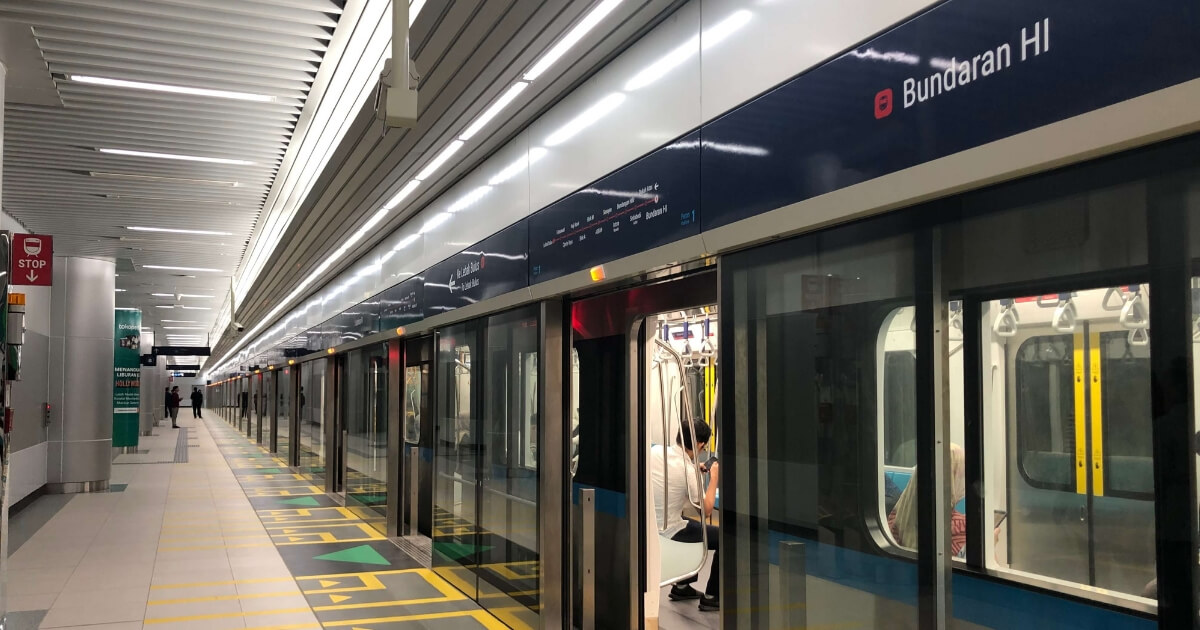Living in a city of just under 10 million (excluding the satellite cities), Jakartans have long been crying out for more public transportation options to escape the maddening traffic jams. That’s why so much hope and hype has been placed in Jakarta’s Mass Rapid Transit system (MRT), which officials say is scheduled for a full launch at the end of this month.
Roughly 40 years after it was first conceptualized and almost a decade after then-Governor Joko Widodo’s administration finally pushed for the project off the ground, yesterday I scored a chance to ride the new MRT Jakarta during its public trial run. I departed from Lebak Bulus, the first station of the MRT’s first phase, with the last stop being the Hotel Indonesia Roundabout (Bundaran HI) in Central Jakarta.

My experience will likely not reflect the reality of daily commuting on the MRT once it’s in full swing. For example, my e-ticket was scanned by volunteers upon entry at Lebak Bulus since the ticket barriers and machines are not yet functioning. They also handed small yellow stickers to the handful of trial commuters eagerly rushing to get on board.
My foremost impression of the new mass transit option is that the MRT’s facilities are very polished and modern. The stations, at the very least, rival those of neighboring Singapore and Kuala Lumpur (the ones we have looked upon with envy for so, so long). I couldn’t help but feel like the MRT is some kind of divine compensation for so many years of struggle and discomfort experienced by the capital’s long suffering commuters.
As I boarded the train, it felt surreal hearing the automated announcement of stations with names I was already familiar with such as Fatmawati, Cipete Raya, and Blok M — it was like I was arriving at these South Jakarta hubs from somewhere in the future.
Perhaps what gave me that impression was how comfortable, quick, and smooth the ride especially compared to the bumpy KRL Commuterline. For now, (and, I hope, for a long time to come) the trains — referred to as Ratangga based on the ancient Javanese word for chariot — were also squeaky clean.
My train completed its trip from Lebak Bulus to Bunderan HI in about 30 minutes, which is a stark contrast to the usual 45 minutes to 1 hour ride by car required when taking the TransJakarta from Lebak Bulus or surrounding neighborhoods in South Jakarta.

Should the relatively short MRT ride whet your thirst and/or appetite, you’ll be glad to know that mini markets and cafe chains are already under construction inside the stations.
It’s also important to note that all of the MRT’s stations have been equipped with elevators and escalators that should hopefully ease access for people with disabilities.
I exited the Bunderan HI Station through Exit A, which is conveniently placed just next to Plaza Indonesia/Grand Hyatt Hotel and within walking distance to Grand Indonesia, Hotel Indonesia Kempinski, and other places around Kebon Kacang.
Stretched over 16 kilometers, there are 13 stations in the first phase of MRT Jakarta, with six elevated stations from Lebak Bulus to Sisingamangaraja, and seven underground stations starting from Senayan to Bundaran HI. Bundaran HI will be the first station to be integrated with a TransJakarta bus stop, which is still under construction at the moment.
Reflecting on my maiden MRT ride, it’s clear that its far and away the best mass transportation option Jakartans now have, at least in terms of comfort and efficiency, and it may indeed entice people some to ditch their private vehicles for the train.
That, of course, depends heavily on the will of Jakartans themselves and whether or not they find the fare to be affordable. While ticket prices have not yet been officially announced, MRT operators have suggested a fare of IDR8,500-IDR10,000 (US$0.60-US$0.70) per 10 kilometers traveled, which would prove to be quite a bit of bang for your bucks.
It remains to be seen how much of an impact the long-delayed project will make on Jakarta’s terrible traffic once it is in full swing. Some have questioned whether the first phase, which only consists of the one South-Central line, will be able to change enough people’s commuting patterns to make it worthwhile.
But hopefully it will find success in making the capital’s macet less awful, which should help speed the way for further developments connecting more of Jakarta’s vast neighborhoods (construction on phase 2 of the MRT is actually already planned to begin this year).
You can still order your MRT public trial tickets on Bukalapak, but keep in mind tickets for entrance to most stations are already sold out. There are four sessions each day during the public trial run: 8 am – 10 am, 10 am – 12 pm, 12 pm – 2 pm, and 2 pm – 4 pm.
The exact date that the MRT will be open commercially to the general public hasn’t been announced yet, but officials have suggested that it will be before the end of March.



Reader Interactions